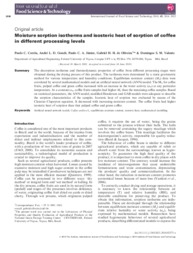Moisture sorption isotherms and isosteric heat of sorption of coffee in different processing levels.
Moisture sorption isotherms and isosteric heat of sorption of coffee in different processing levels.
Author(s): CORRÊA, P. C.; GONELI, A. L. D.; AFONSO JUNIOR, P. C.; OLIVEIRA, G. H. H. de; VALENTE, D. S. M.
Summary: The desorption isotherms and thermodynamic properties of coffee from different processing stages were obtained during the drying process of this product. The isotherms were determined by a static gravimetric method for various temperature and humidity conditions. Equilibrium moisture content (Me) data were correlated by several mathematical models and an artificial neural network (ANN) model. The Me for coffee fruits, pulped coffee and green coffee increased with an increase in the water activity (aw) at any particular temperature. At a constant aw, coffee fruits samples had higher Me than the remaining coffee samples. Based on statistical parameters, the ANN model, modified Henderson and GAB models were adequate to describe the sorption characteristics of the samples. Isosteric heat of sorption was evaluated by means of the Clausius?Clapeyron equation. It decreased with increasing moisture content. The coffee fruits had high isosteric heat of sorption than that pulped coffee and green coffee.
Publication year: 2010
Types of publication: Journal article
Unit: Embrapa Coffee
Observation
Some of Embrapa's publications are published as ePub files. To read them, use or download one of the following free software options to your computer or mobile device. Android: Google Play Books; IOS: iBooks; Windows and Linux: Calibre.
Access other publications
Access the Agricultural Research Database (BDPA) to consult Embrapa's full library collection and records.
Visit Embrapa Bookstore to purchase books and other publications sold by Embrapa.

